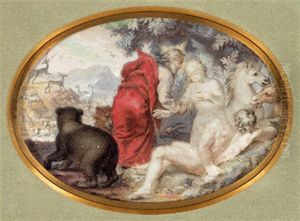Augustin Hirschvogel Paintings
Augustin Hirschvogel was a renowned German artist, known primarily for his work as a cartographer, glass painter, and particularly as an engraver. Born in 1503 in Nuremberg, a city famous for its thriving artistic and cultural scene during the Renaissance period, Hirschvogel came from a family with a background in the arts, which likely influenced his early interest and eventual career path in the artistic field. His contributions to the art world during the 16th century were significant, particularly in the realm of printmaking and cartography, areas in which he excelled and innovated.
Hirschvogel's training and early career are not extensively documented, but it is known that he was active in Vienna from around 1525. His works from this period include both religious and secular subjects, showcasing his versatility as an artist. However, Hirschvogel is perhaps best remembered for his engravings, a medium through which he demonstrated remarkable skill and precision. His engravings covered a wide range of subjects, including maps, landscapes, and architectural drawings, the latter of which displayed his keen interest in perspective and detailed representation.
One of Hirschvogel's most significant contributions to the field of cartography was his map of Vienna, created in 1547. This map is notable not only for its accuracy but also for its detailed depiction of the city, offering valuable insights into the urban layout and architectural landscape of Renaissance Vienna. Beyond his maps, Hirschvogel's landscape etchings were among the earliest examples in the German-speaking world, reflecting a growing interest in the natural environment and its aesthetic qualities during this period.
Augustin Hirschvogel's work was influential in his time and continues to be studied for its artistic and historical significance. Despite facing financial difficulties later in life, which led him to move to Vienna in search of better opportunities, Hirschvogel's legacy as a pioneering figure in engraving and cartography endures. He passed away in 1553, but his contributions to the arts, particularly in the areas of printmaking and mapmaking, remain a testament to his talent and vision.



